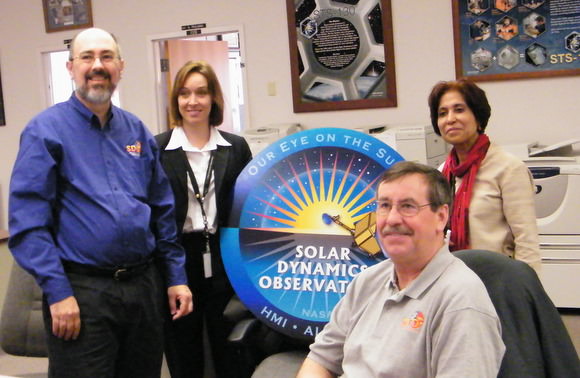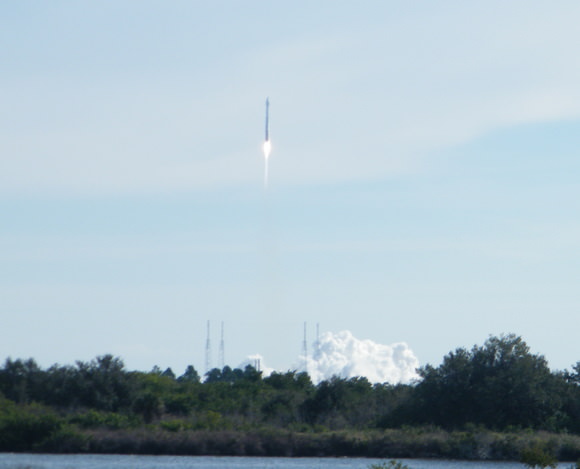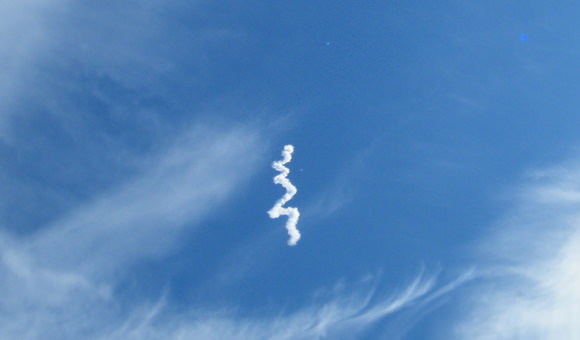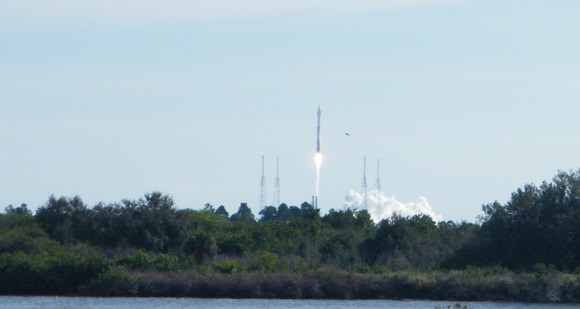Videographers David Gonzales and Mike Deep filmed Endeavour’s final launch with two cameras from the Kennedy Space Center Press Site, and put this video together for Universe Today. They did a great job of capturing what a shuttle launch sounds like, from the countdown, to the cheering of the crowd, to the crackling and popping of the launch itself.
Continue reading “The Sights and Sounds of Endeavour’s Final Launch”
The Solar Dynamics Observatory Soars to Study the Sun
The Solar Dynamics Observatory launched successfully – and beautifully – Thursday morning from Cape Canaveral Launch Complex 41 to begin a 5-year mission that will provide streaming, high-definition views of our sun. It was the 100th launch of the Atlas/Centaur combo, and was a gorgeous sight as it roared and soared into the blue Florida sky. “It was great; a beautiful launch,” said Dean Pesnell, SDO Project Scientist, immediately after the launch. “The rocket rises so slowly off the pad — it is wonderful to see. This is third Atlas launch I’ve seen and this is the best one so far.”
Amazingly, viewers here at Kennedy Space Center saw the Atlas rocket fly close to a sundog just as the spacecraft reached Max-Q, creating a ripple effect around the spacecraft. “We saw this sundog come out and SDO flew right through it. Then the sun dog disappeared,” said Pesnell. “This may be the first time we’ve sent a probe through a sundog, and people will be studying this, so already we are learning things about our atmosphere from SDO.”
See this amazing video shot by a 13-year-old girl in attendance at the KSC VIP site that shows the sundog and shockwave. (as noted by Jon Hanford in the comments).
Today’s countdown was extremely smooth as the high winds that thwarted Wednesday’s launch attempt calmed as the opening of the launch window approached. After counting down to the planned T-4 minute hold, launch managers proceeded directly to launch at the beginning of the window at 10:23 a.m. EST.

“I was a little worried about the clouds coming in,” said Tom Woods, Principal Investigator for the EVE instrument on SDO, the EUV Variability Experiment, which will be studying the extreme ultraviolet radiation of the Sun. “But we were very excited to see SDO launch today, as otherwise it would have been a 10-day delay until the next attempt. It was a wonderful launch!”
“It was so beautiful,” said Lika Guhathakurta, SDO program scientist immediately following the launch as we walked together back to the press building. “I can still feel the rumbling in my stomach!”

Called the “Crown Jewel” of NASA’s fleet of solar observatories, SDO is a technologically advanced spacecraft that will take images of the sun every 0.75 seconds and daily send back about 1.5 terabytes of data to Earth — the equivalent of downloading 380 full-length movies every day.

“We’re going to be able to better understand the Sun as a star,” said Guathakurta, “but SDO will also give us a comprehensive view of how it interacts with the Earth and everything else in the solar system.
The sun’s dynamic processes affect everyone and everything on Earth. SDO will explore activity on the sun that can disable satellites, cause power grid failures, and disrupt GPS communications. SDO also will provide a better understanding of the role the sun plays in Earth’s atmospheric chemistry and climate.

A contrail from the launch appeared only in the region of Earth’s atmosphere where conditions were right for cloud formation. “There weren’t any clouds there, but we provided the very fine particles so that a contrail cloud appeared,” said Pesnell.
A later update confirmed that SDO separated from the Centaur and the spacecraft’s solar arrays deployed on time and correctly, and are now generating power.
Here’s the video of the launch from NASA TV:
After Loss of Lunar Orbiter, India Looks to Mars Mission
[/caption]
After giving up on re-establishing contact with the Chandrayaan-1 lunar orbiter, Indian Space Research Organization (ISRO) Chairman G. Madhavan Nair announced the space agency hopes to launch its first mission to Mars sometime between 2013 and 2015. Nair said the termination of Chandrayaan-1, although sad, is not a setback and India will move ahead with its plans for the Chandrayaan-2 mission to land an unmanned rover on the moon’s surface to prospect for chemicals, and in four to six years launch a robotic mission to Mars.
“We have given a call for proposal to different scientific communities,” Nair told reporters. “Depending on the type of experiments they propose, we will be able to plan the mission. The mission is at conceptual stage and will be taken up after Chandrayaan-2.”
On the decision to quickly pull the plug on Chandrayaan-1, Nair said, “There was no possibility of retrieving it. (But) it was a great success. We could collect a large volume of data, including more than 70,000 images of the moon. In that sense, 95 percent of the objective was completed.”
Contact with Chandrayaan-1 may have been lost because its antenna rotated out of direct contact with Earth, ISRO officials said. Earlier this year, the spacecraft lost both its primary and back-up star sensors, which use the positions of stars to orient the spacecraft.
The loss of Chandrayaan-1 comes less than a week after the spacecraft’s orbit was adjusted to team up with NASA’s Lunar Reconnaissance Orbiter for a Bi-static radar experiment. During the maneuver, Chandrayaan-1 fired its radar beam into Erlanger Crater on the moon’s north pole. Both spacecraft listened for echoes that might indicate the presence of water ice – a precious resource for future lunar explorers. The results of that experiment have not yet been released.
Chandrayaan-1 craft was designed to orbit the moon for two years, but lasted 315 days. It will take about 1,000 days until it crashes to the lunar surface and is being tracked by the U.S. and Russia, ISRO said.
The Chandrayaan I had 11 payloads, including a terrain-mapping camera designed to create a three-dimensional atlas of the moon. It is also carrying mapping instruments for the European Space Agency, radiation-measuring equipment for the Bulgarian Academy of Sciences and two devices for NASA, including the radar instrument to assess mineral composition and look for ice deposits. India launched its first rocket in 1963 and first satellite in 1975. The country’s satellite program is one of the largest communication systems in the world.
Sources: New Scientist, Xinhuanet
Launch Images from LRO/LCROSS Successfull Liftoff
Liftoff! A patient launch control team waited out stormy weather on Thursday, and finally were able to give a green light for the last launch opportunity of the day for the Atlas rocket carrying the Lunar Reconnaissance Orbiter (LRO) and Lunar Crater Observation and Sensing Satellite (LCROSS). The duo lifted off at 21:42 pm GMT (5:32 pm EDT), climbing through some impressive looking clouds and quickly heading to space. For more information about the missions, see our LRO/LCROSS preview article. View the video of the launch, above, and using the wonders of NASA TV on the web and my image clipping tool here are more pictures from the launch:
Here are a few pre-launch images:
[/caption]
Shortly after liftoff with the launch complex visible below:
View from the spacecraft heading up through the clouds.
The curvature of Earth and the blackness of space visible from this image taken by cameras on the spacecraft.
As of this writing, all systems are in good shape.


